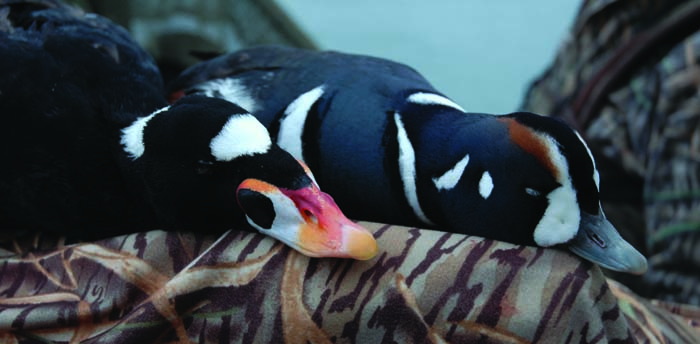Alaska
 Southern Alaska has it all in terms of waterfowl. Inland and on the saltwater marsh flats, you’ll find mallards. Trip to the coast, and you’ll find a variety of divers — including goldeneyes, bufflehead and bluebills — as well as a selection of wall-worthy sea ducks such as harlequins and a trio of scoters (white-wings, blacks and common).
Southern Alaska has it all in terms of waterfowl. Inland and on the saltwater marsh flats, you’ll find mallards. Trip to the coast, and you’ll find a variety of divers — including goldeneyes, bufflehead and bluebills — as well as a selection of wall-worthy sea ducks such as harlequins and a trio of scoters (white-wings, blacks and common).
A word of warning — Alaska saltwater hunting isn’t for the inexperienced nor the ill-equipped. The gunning possible in a sheltered cove off Kodiak Island or on some of the protected waters between Juneau and Ketchikan would be foolhardy at best — deadly, at worst — in less-forgiving locales. That said, consider a guide, or at least good equipment, local knowledge and common sense. More information is available at www.adfg.state.ak.us.
Colorado
I enjoy some phenomenal Canada goose hunting near my home in eastern Iowa. Still, I’d trade at least half of those birds for the chance to gun Greaters from a west-facing layout blind, where I had a ringside seat to the beauty, power and majesty that is Colorado’s Front Range. There’s just something about that combination of “take ’em!” and the Rocky Mountains that can’t be beat.
Still, the sleeper that it was a decade ago, Colorado’s Front Range continues to produce excellent late-season goose hunting for those hardcores who don’t mind snow, wind and downright nasty temperatures. When I was there a handful of years ago, we hunted both the South Platte River near the town of Platteville, as well as some private holdings around Greeley, a ’burg now recognized as paradise among the dedicated goose-hunting crowd. The Platte was a wonderful shallow-water duck hunt, with some bonus Canadas coming later each morning after the principal mallard flight. Greeley, however, involved specifically Canadas hunted from traditional pits over full-body spreads — and boy howdy! The shooting was as hot as the temperatures were cold. Today, there are several public gunning opportunities along the South Platte between Greeley and east to Fort Morgan and behind; however, much of the better Canada goose hunting in this so-called Golden Triangle is accessed through established outfitters on private lands. More information is available at www.wildlife.co.state.us.
Wyoming
While I absolutely love hunting big rivers — the Columbia, Mississippi and Missouri all come immediately to mind — it’s the smaller flows, with their ankle-deep runs of always-open riffles, pools and around-the-corner coves, that really get me going. As a freelance waterfowler, such shallow rivers were seemingly created specifically for me and my lightweight gear — which includes an easy-walking set of chest waders, a dozen good-looking decoys, a bare-minimums blind bag and a black Lab. Other times, I’ll slip a pumpkinseed boat off the roadside and into a quiet backwater. From there, I’ll slink my way downstream, stopping occasionally to toss out a half-dozen mallard blocks anywhere the birds tell me I should be setting up shop. It’s solitary, it’s revitalizing, and more often than not, it’s a method that puts river ducks on my strap.
If this is you, and you can look beyond the mule deer and the pronghorns, then Wyoming definitely deserves a look. A good friend hunts the Belle Fourche River in the extreme northeast corner of the state; a meandering stretch of stream that flows through as picturesque a country as anywhere in the state. Above Cheyenne, the North Platte holds great numbers of Canadas and mallards throughout December and into January. The Bighorn, Powder and Sweetwater rivers, too, offer opportunity for the man willing to work and dress warmly, and who doesn’t mind the additional weight of four big greenheads on his belt. More information is available at www.gf.state.wy.us.
Montana
Big Sky Country isn’t all blue-ribbon trout streams. Yes, Montana has some of the finest fly-fishing on the planet, but those same cobblestone rivers that produced excellent angling in early May can also provide fantastic gunning for a variety of puddlers and divers come November.
Where to begin? Truth is, any flowage, Eastside or Westside, can be hot — or not — depending upon the traditional waterfowling variables of weather, calendar and hunting pressure. South of Interstate 90 between Butte and Bozeman, the Yellowstone, Gallatin, Madison and Beaverhead rivers all hold potential for the gunner who appreciates a steady diet of mallards and Canadas, with the occasional flock of goldeneyes. In the northeastern part of the state and above I-94, the Missouri River offers a bit more water for those ’fowlers equipped to navigate larger flows. Here, too, streams such as the Musselshell and the Yellowstone take a man back to the small-water-and-handful-of-decoys scenario.
If still water is more to a gunner’s liking, Montana handles that right nicely. The Charles M. Russell National Wildlife Refuge (NWR) on Fort Peck Lake, an impoundment on the Missouri, offers waterfowling throughout the regular season. So, too, does the Medicine Lake NWR in Sheridan County, as well as the Lake Mason and War Horse refuges, both sister systems to Charles M. Russell and both located due south of the main facility. More information is available at www.fwp.state.mt.us.
For ages, the West and big-game hunting have been synonymous; however, for gunners who don’t mind their quarry a bit smaller, a bit quicker and a little more feathered, the American West certainly won’t disappoint. Besides, I’d much rather pack out a pound-and-a-half harlequin than I would a 1,000-pound bull elk.






